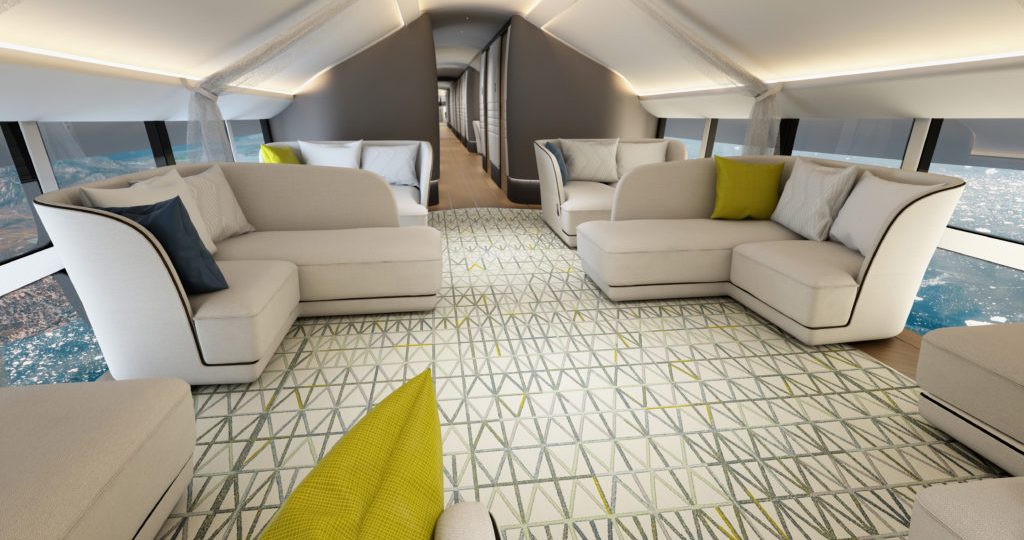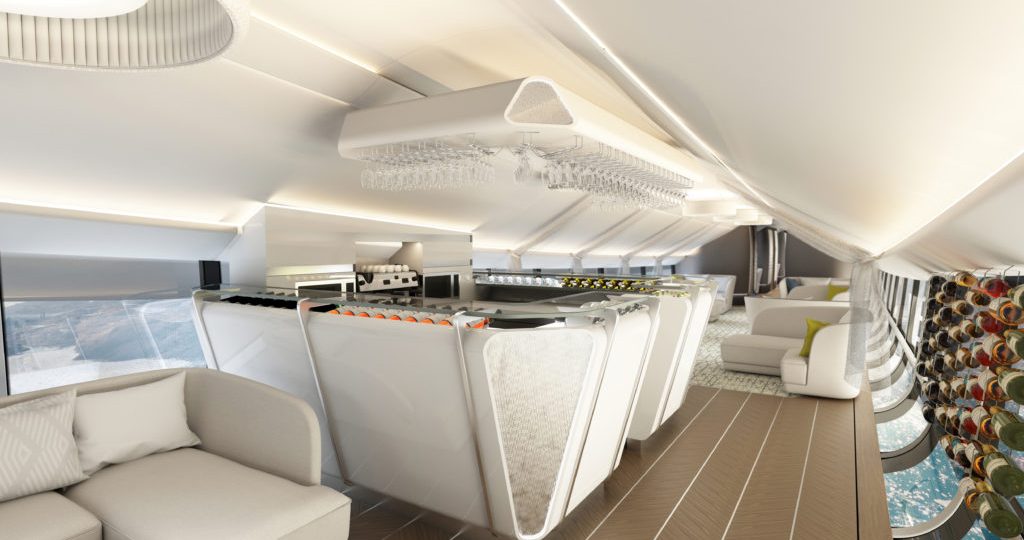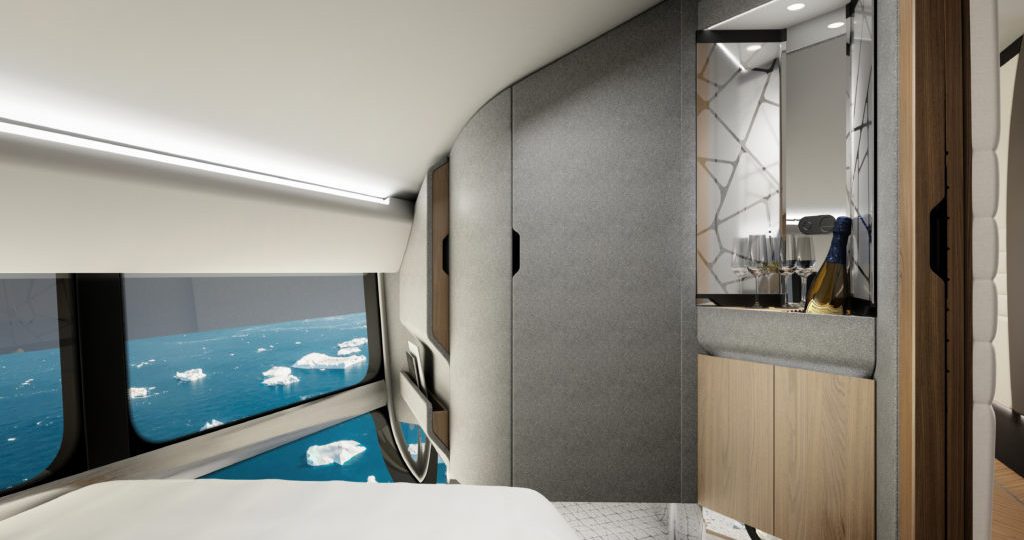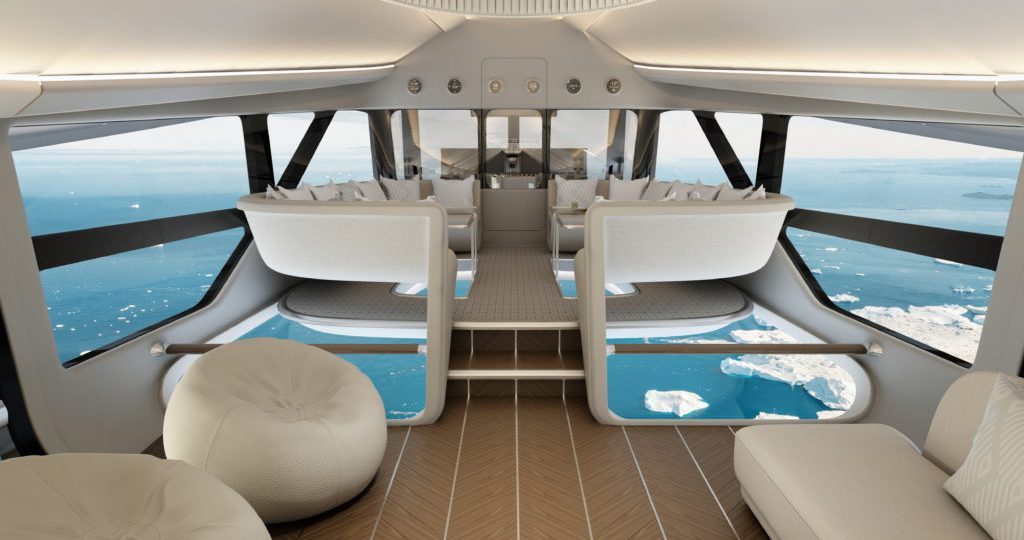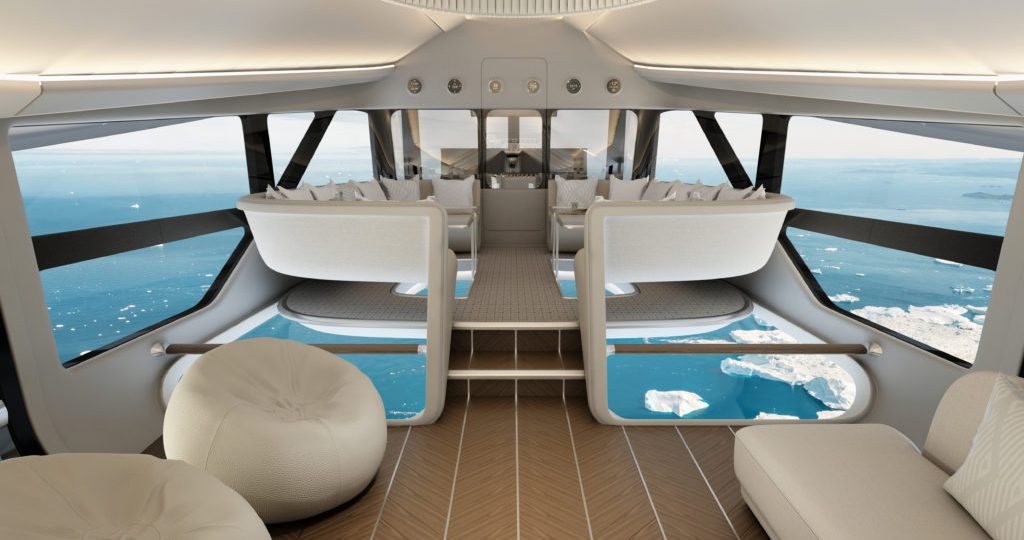Windows on the world

How long have you been involved in this project?
Almost 12 months. Design Q was approached early last year to help design the interior and we supported HAV in applying for and winning a design grant. As part of our partnership with HAV, we have an agreement to provide design and some engineering expertise for the project, as well as supplying new and unique products for Airlander 10.
HAV aims to have the first aircraft fully fitted in two-to-three years. Once in production each interior should take around six-to-eight months to complete.
What was the brief?
We were briefed to design an interior that could cater for 18 passengers, plus crew, providing space for sleeping, dining, social groups, retreat spaces and within a maximum 10 tonnes total interior weight. Airlander 10 is to have a maximum altitude of 10,000 feet so it will not require pressurisation. Because the ship is not concerned with speed or height, it allows the cabin to be designed and engineered in simple robust way
It was very exciting to work on a project where no one has gone before, but also quite a responsibility! We learned a lot during the process. As a design house, our objective was to think as far out of the box as possible, but within our own knowledge and experience, so we could be certain that what we have designed can be achieved.
Inspirations for the first ship had to appeal to various different types of customer with a range of geographic backgrounds. The interior includes flooring of wood and stone perfected by F/List, carpets of silk handmade by Tai Ping and seating systems developed by Pitch Aircraft Seating.
With no jet aircraft take off, and a generally slower, gentler movement, do you have fewer restrictions on seat choice, and monument fixing etc?
Generally the interior is far more flexible than a conventional jet, and we have created a design that breaks all the rules set by current commercial aircraft.
Everyone on board has to be belted for take off and landing, but to requirements of 3G, not 16G, like a jet. 3G allows take off and landing from a sofa rather than a chair and due to the massive space on board it has allowed us to invent a new seating system.
Each passenger gets 10 times more space than the most generous commercial jet First Class cabin. The furniture can be reconfigured in flight, and when we talk about luxury we mean the best of everything, including comfort and the experience. From many points on the aircraft the scope of vision of the surrounding panoramas is mind blowing.
“There are windows everywhere – sideways, forwards, aft, and even downwards.” Howard Guy, CEO Design Q.
The galley is big enough for chefs from Michelin-starred restaurants to cater for 18 guests. It also works as a bar, with some unique and clever touches, especially if you are partial to some of the rare and fine liquors.
The dining area comfortably seats all passengers, but allows face to face serving and access due to the clever split of tables, with a walkway. It is designed in a way that everyone has a great view in every direction, including down! This area can be used for mission briefings and presentations on board by tour celebrities and experts!
The open social space faces into the cabin or can be a private space facing outwards to drink in the ‘once in a lifetime’ views. In the private suites you will find a double bed, the necessary storage space and the obligatory 34-inch TV. The drinks cabinet and refreshment centre offer the customer his or her favourite nibbles.
Can you describe some of the unique features and touches you have incorporated?
The open flight deck is a first in the industry, as are the glass floors – or floor windows. There are also double suites, with three-metre-wide floor to ceiling windows.
A number of other new craft techniques and materials have been incorporated, but we cannot reveal full details yet, as we are in the process of registering and patenting some of them. Currently, only 50 per cent of the interior has been revealed, so over the next year more breath-taking elements of Airlander 10 will be revealed by Design Q.
“This ship can actually stand still for long periods of time if the scene unfolding below demands attention.” Howard Guy, CEO Design Q.
Will this be offered as the Airlander 10’s production interior?
Yes, this will be offered as a production interior. However, different layouts will be available and the style of the interior can be customised to the operator’s brand or taste. The interior has been designed to be able to configure to customers’ requirements.
With so much glass, is there an in-built window shading system?
Yes, automatic black out and shades are incorporated into the window system.
I do not believe there is a black out inter glass system like 787 that could cope with the size of the windows, Airlander having windows eight times larger than the largest commercial or business jet!
What opportunities are offered by this airframe?
The Airlander 10 can land anywhere without any infrastructure. I am not sure if there are plans for water landings, but that would not be out of the question. Snow, ice, sand, grass, stone and concrete are all straightforward surfaces for Airlander, as long as there is a wide enough space to land.
When viewing wildlife and the countryside, the lower the altitude and the slower you go, the more you see. This ship can actually stand still for long periods of time if the scene unfolding below demands attention. No other flying object other than a hot air balloon comes close to the experience, but even a balloon cannot stay motionless or circle and have a second look!
How did certification/safety requirements influence the design?
The Airlander is subject to the same fire and toxicity regulations, but this does not compromise any of the design opportunities. Emergency escapes are much easier due to many windows being able to open throughout the cabin.
Which aspects might be the hardest to implement?
Weight is going to be a challenge overall, partly because of the weight of the things you need in order to cater for 22 people over a three-day excursion – water, bottles, food, crockery, cutlery, crystal, table linen, bed linen, towels, and 22 people plus luggage. Add to this the weight of all the furniture, galley with coffee machine, fridges, sinks, microwave/ovens and all the electrics, lighting, ceilings, glass flooring, and it will be challenging.
Fast facts
- The Airlander 10 is the world’s longest aircraft. At 92 metres, it is over 18 metres longer than the world’s largest passenger plane, the A380.
- The 46-metre-long cabin contains en suite bedrooms, an on-board bar, socialising area and dining/briefing area.
- It can reach heights of up to 6,100 metres. Part-airship, part-helicopter, part-plane, it is lifted by 38,000 cubic metres of helium.
- Airlander 10 is slow. The four 325 horsepower V8 diesel engines propel it to speeds of up to 148kmph and provide vertical thrust for horizontal take-offs.
- It is capable of carrying a payload up to 10 tonnes.
- It is green, compared to jets, as it has low fuel consumption and engine noise levels.
- It has retractable pneumatic ‘skids’ that can be used for landing on earth, sand, water or ice.
- It has capacity for 19 passengers.
- It has glass floors, as well as acres of glass windows, offering horizon-to-horizon views.
- It is able to stay airborne for up to five days with refuelling.

